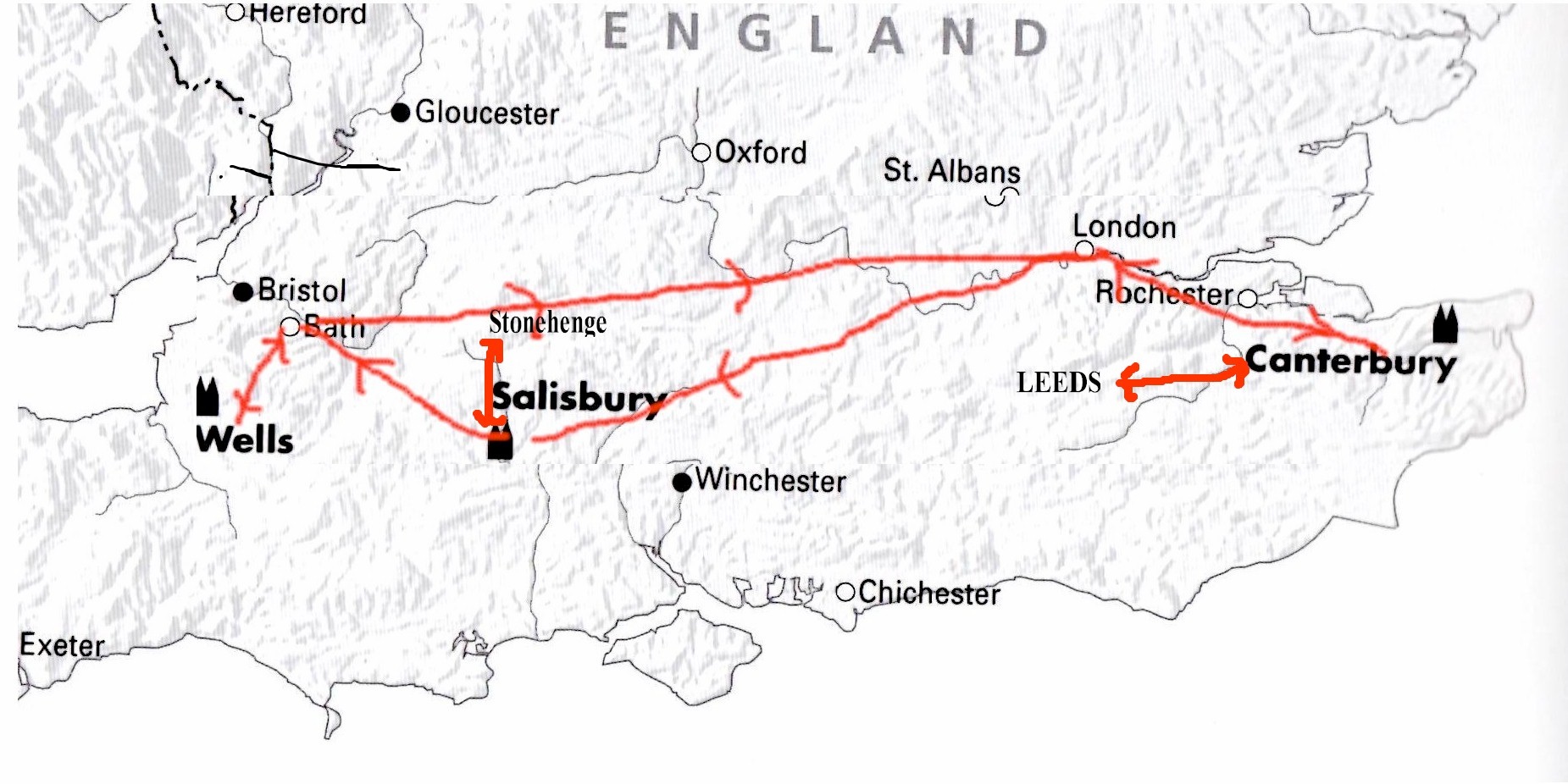CATHEDRAL QUEST
Our quest to experience the great cathedrals and churches of Europe
ENGLAND
2003
Day 7 , April 11, 2003 - Friday
From Salisbury to Bath and Wells
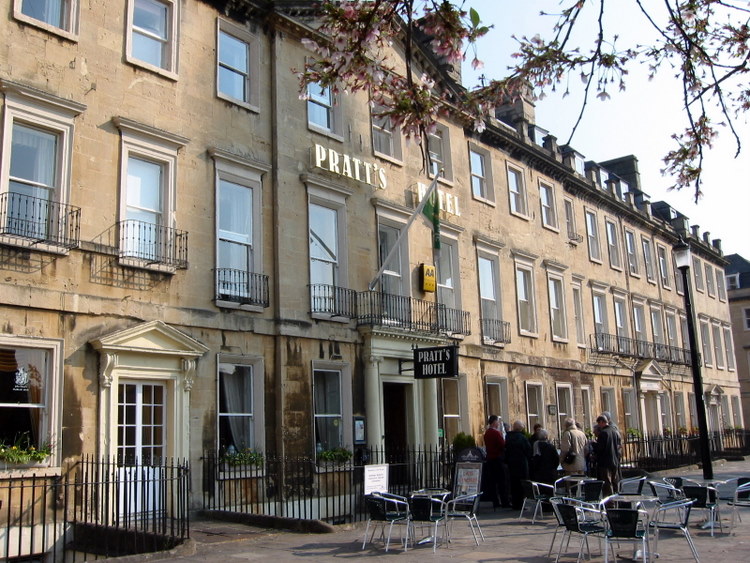
After we had breakfast at the Red Lion, we took a taxi to the train station.
The train to Bath just had two cars.
We had reservations at the Pratt's Hotel, which was only two blocks from
the train station, so we walked to our hotel.
Pratt's Hotel has been part of the city’s heritage for more than two
centuries. Built from the famous
Bath honey-colored stone by one the city’s most famous architects in 1743, the
hotel was originally built as five town house.
The building itself has many interesting features, including the bowed
landing on the staircase designed to enable the “chairmen” to take their
clients back to their rooms following their treatments in the famous Spa Baths.
Upon
arrival, we registered in the hotel, took our luggage to our room and
immediately walked to the bus station which was near the train station.
Our destination was the Wells cathedral.
Bus 173 left at 11:05 for Wells. It
was only 22 miles to Wells, but the bus trip took over an hour and a half.
It stopped at every cross road to pick up local folks.
Ladies got on with baby strollers. Other
people boarded with their arms full of groceries and even their dogs.
It appeared to be the local social hour.
We finally arrived in Wells and found it a lively, charming old town. We found the Cathedral easily, sitting back on vast green lawn inhabited by people of various ages taking advantage of the beautiful spring day. The façade of the cathedral is awesome. It is covered with hundreds of statues. Many of the lower ones have been defaced and others completely destroyed leaving an empty niche.
A BIT OF HISTORY
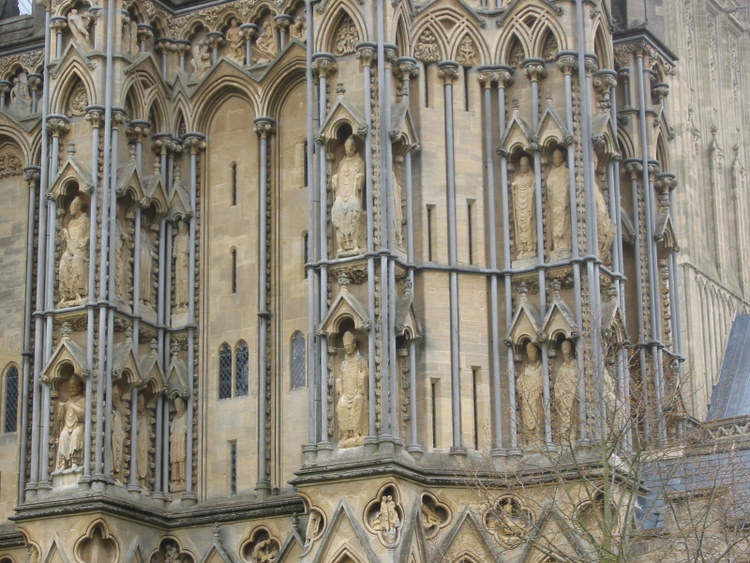 Behind
the cathedral are five springs, five holy well, which gave the city its name.
There have been shrines in Wells for two thousand years.
In 705 the King of Wessex gave land to the Bishop of Sherborne to build a
church. In 909 it became a
cathedral. After William the
Conqueror, John of Tours moved the bishop’s throne to Bath in 1088.
A hundred years later, 1180, Bishop Reginald moved it back to Wells and a
new cathedral was started. This
church was the first church in England planned and completed in the Gothic
style. Taking only sixty years to
build, the church was completed in
1239. The central tower was completed in 1322, the southwest tower in 1394 and
the northwest tower in 1436.
Behind
the cathedral are five springs, five holy well, which gave the city its name.
There have been shrines in Wells for two thousand years.
In 705 the King of Wessex gave land to the Bishop of Sherborne to build a
church. In 909 it became a
cathedral. After William the
Conqueror, John of Tours moved the bishop’s throne to Bath in 1088.
A hundred years later, 1180, Bishop Reginald moved it back to Wells and a
new cathedral was started. This
church was the first church in England planned and completed in the Gothic
style. Taking only sixty years to
build, the church was completed in
1239. The central tower was completed in 1322, the southwest tower in 1394 and
the northwest tower in 1436.
We
had not been able to secure a private tour prior to our leaving home, but they
assured us that we would have a good tour.
We had an hour before our tour, so we went into the lunch room.
Like Salisbury Cathedral, the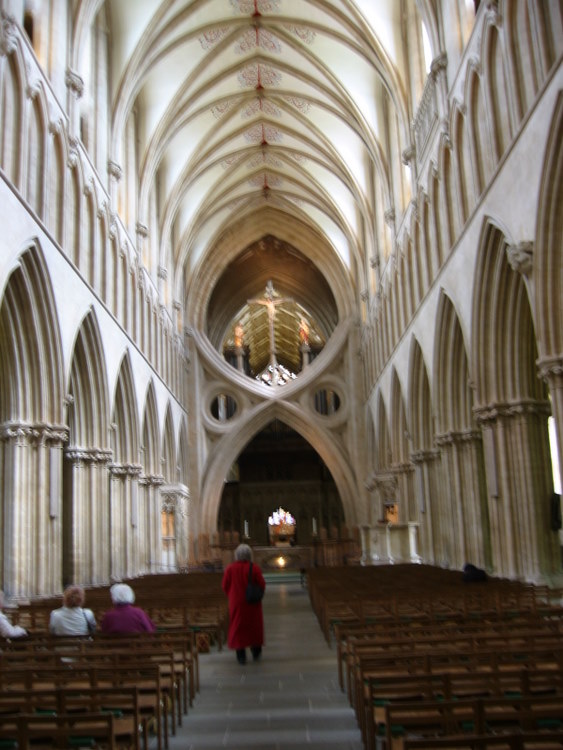 cathedral had taken a section of the
cloister and made it into a cafeteria.
There were long tables with benches.
We both had a quiche and sat with some local folks.
cathedral had taken a section of the
cloister and made it into a cafeteria.
There were long tables with benches.
We both had a quiche and sat with some local folks.
We found our guide, gave her a copy of the Washington Cathedral book, and began an outstanding tour. One of my fellow docents at the Washington Cathedral, Kathleen Smith, had been in Wells Cathedral the week before and our docent, Val Stevens, had given her a tour—small world.
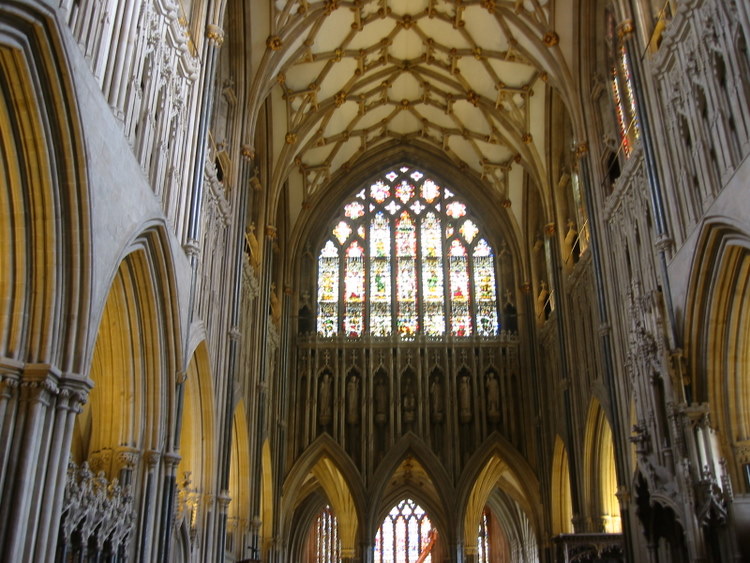
The
first thing that one notices upon
enter the church are the scissor arches. The
arches at the great crossing under the central tower are crisscrossed to give
added support to the tower that is above.
These were added between 1338 and 1348 when the foundation began to sink.
The tower itself began to lean and crack.
The scissors arches were successful and the tower still remains stable.
As in Westminster Abbey and Canterbury Cathedral, there is a quire screen
or pulpitum on which the organ has stood since 1335.
In
the quire we experienced our first view of misericords.
We will see misericords in other cathedrals.
The misericords were used by the clerics to rest their “bottoms”
during long periods of standing. These
seats in the quire have a hinged bottom. The
bottom or seat can be raised up to allow the clerics to rest on them –
appearing to be standing - during long services.
On the underside of the seat is an interesting carving, only visible when
the seat is raised. We always looked
for misericords in each cathedral we visited.
 An interesting item in the cathedral’s north transept is a mechanical clock.
It has been reminding worshippers of the time for over 600 years. It is a
full 24 hour clock. There is an
inner circle which tells the minutes plus another inner circle that indicates
the number of days since the last full moon.
The mechanical knights above the clock rotate every quarter hour. Jack
Blandiver, a mysterious carved figure high up to the right, rings the bells.
It is really unique. We will
encounter a similar clock in Strasbourg and Beauvais.
An interesting item in the cathedral’s north transept is a mechanical clock.
It has been reminding worshippers of the time for over 600 years. It is a
full 24 hour clock. There is an
inner circle which tells the minutes plus another inner circle that indicates
the number of days since the last full moon.
The mechanical knights above the clock rotate every quarter hour. Jack
Blandiver, a mysterious carved figure high up to the right, rings the bells.
It is really unique. We will
encounter a similar clock in Strasbourg and Beauvais.
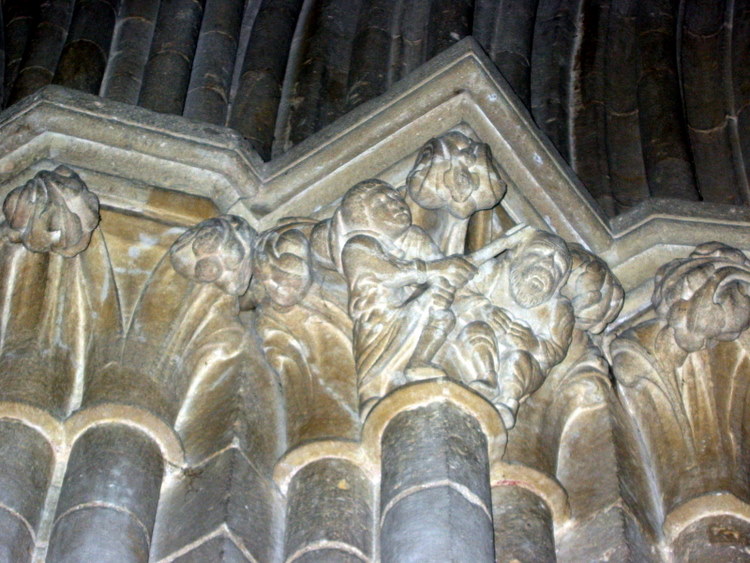
Another
interesting feature is the carvings at the tops of the pillars- the capitals.
They, in rather humorous characters, tell everyday stories from medieval
life such as a man removing a thorn from his foot or another man with a tooth
ache. Several columns have a
continuous story all round the top, sort of like a comic strip.
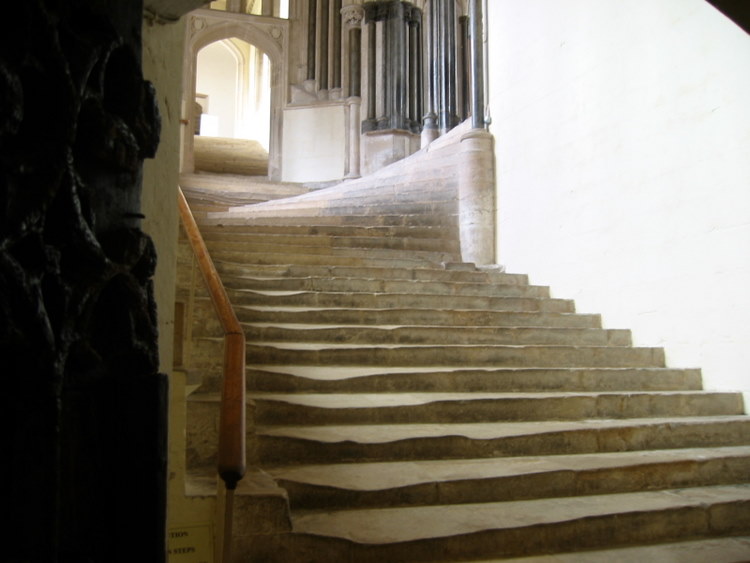
A
photo published in many books about Wells cathedral shows the worn wall to wall
stair case leading to the Chapter Room. The picture on the left is my
photograph. The ceiling of the Chapter House, like that at Salisbury, was
amazing with the center column fanning out to meet the fan arches of the side
columns.
 An interesting item in the cathedral’s north transept is a mechanical clock.
It has been reminding worshippers of the time for over 600 years. It is a
full 24 hour clock. There is an
inner circle which tells the minutes plus another inner circle that indicates
the number of days since the last full moon.
The mechanical knights above the clock rotate every quarter hour. Jack
Blandiver, a mysterious carved figure high up to the right, rings the bells.
It is really unique. We will
encounter a similar clock in Strasbourg and Beauvais.
An interesting item in the cathedral’s north transept is a mechanical clock.
It has been reminding worshippers of the time for over 600 years. It is a
full 24 hour clock. There is an
inner circle which tells the minutes plus another inner circle that indicates
the number of days since the last full moon.
The mechanical knights above the clock rotate every quarter hour. Jack
Blandiver, a mysterious carved figure high up to the right, rings the bells.
It is really unique. We will
encounter a similar clock in Strasbourg and Beauvais.
Another interesting feature is the carvings at the tops of the pillars- the capitals. They, in rather humorous characters, tell everyday stories from medieval life such as a man removing a thorn from his foot or another man with a tooth ache. Several columns have a continuous story all round the top, sort of like a comic strip.

A
photo published in many books about Wells cathedral shows the worn wall to wall
stair case leading to the Chapter Room. The picture on the left is my
photograph. The ceiling of the Chapter House, like that at Salisbury, was
amazing with the center column fanning out to meet the fan arches of the side
columns.
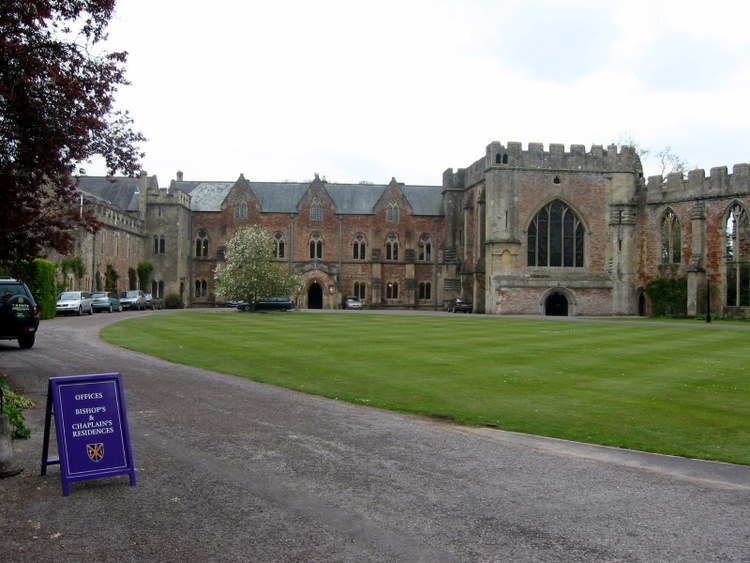 We
went to the Bishop’s Palace and took a tour of it and the Bishop’s Chapel.
Also on the grounds are the remains of the Great Hall .
We
went to the Bishop’s Palace and took a tour of it and the Bishop’s Chapel.
Also on the grounds are the remains of the Great Hall .
Our
intention was to go from Wells to Glastonbury to visit the abbey but we didn’t
have time. It was only six miles
south of Wells, but the bus station attendant said we could take the next bus
but there was not a return bus until the next day.
We weren’t prepared to spend the night so we caught the bus back to
Bath. It made as many and as
interesting stops as on the way down. We
got settled in our hotel room which was rather spacious.
We went to the hotel dining room for dinner.
It was lovely, well appointed room divided into sections.
I had mushrooms for a starter and beef for the entrée.
My wife had carrot soup and sole for dinner.

